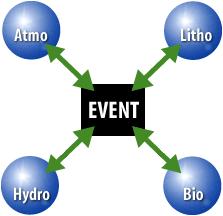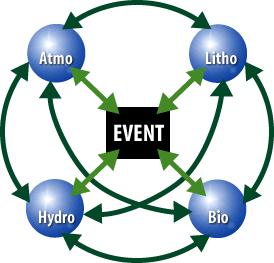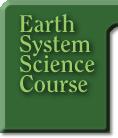Week 1: An
Introduction to an ESS Analysis
Earth system
science is conducted by examining each event to sphere, sphere to
event, and sphere to sphere interaction. This approach is referred
to as an "Earth system science analysis" or an "ESS
analysis."
An ESS analysis is
done in three steps, which include looking at
- how the event
affects each of the spheres;
- how the spheres
affect the event; and
- how the spheres
affect each other.
Because you will be
performing ESS analyses in this course, you should read through
the following information as it provides an overview of how to do
each step of the ESS analysis. The purpose of this introduction is
to get you thinking about the types of interactions that can
occur. The forest fires that occurred in Yellowstone National
Park, Wyoming, in 1988 is used as the event for this introduction.
As you go through the step-by-step process, you should post your
ideas for each of the steps in your journal.
When posting your
analysis ideas, abbreviate the event with the letter "E"
and abbreviate each sphere using the first letter of its name
(atmosphere = A; biosphere = B; etc). Use a single-headed arrow
(>) to indicate the direction of effects. For example, the
effects of the event on the hydrosphere should be written as
"E >H".
Step 1: Event >
Sphere Interactions
How could the event
(Yellowstone fires) affect each sphere? The answers to this
question are the event > sphere impacts. Refer to the Earth
System Diagram below to help you think about the types of
interactions that could occur.

Consider how the
Yellowstone fires might affect the spheres, beginning with the
atmosphere. Remember to write your additional ideas in your
journal.
E > A
The fires
created tremendous heat, developed fast rising columns of heated
air, which in turn brought in more air at the base of the fires,
dropped the humidity in the area of the active fire to near
zero, and made dense smoke, which actually traveled hundreds of
miles.
There were certainly
other impacts on the atmosphere besides this one. What ones can
you think of that might be added to the list?
E > H
Ash from
the fires fell into the ponds, lakes, and streams.
What impacts might
you expect the event to cause in the hydrosphere? Is the effect of
burning embers from the falling debris landing in the streams
worth considering?
Don't worry about
getting “all” the interactions; you probably won't be able to.
Just focus on identifying one or two impacts. And remember, the
impacts on some spheres will be more numerous than on others.
That's not a problem.
E > B
The fires
burned and killed the plants and trees, as well as the animals
who could not escape, in the area.
How else did the
fires affect the biosphere at Yellowstone National Park? There are
the obvious "destructive" effects on plant and animal
life as well as on habitat. You might also consider the
"beneficial" effects of burning off accumulated debris
on the forest floor and similar occurrences that might be
considered advantages of the burning. Add some of these to your
journal.
E > L
The
forest fires burned the parts of the soil where the plants put
down their roots.
Lastly, what effects
might these fires have had on the lithosphere? Here, you might
consider the effects on soils, or perhaps even on the water levels
of the geysers and hot pools the Yellowstone National Park is so
famous for.
Step 2: Sphere >
Event Interactions
How could each sphere
affect the event? The answers to this question are the sphere >
event impacts.
Take another look at
the Earth System Diagram above. Notice that the arrows go not only
from the event to each sphere but also from the spheres back to
the event. While looking at the diagram, ask yourself, "If
this happened to the biosphere because of the fires, how might
that have an effect on the fires themselves?" For example, if
the fires cause the forest floor debris to be burned off in the
biosphere, how might that impact the fires themselves? Clearly,
the fires would be removing the fuel necessary to keep them
burning. So, a statement like, "The leaf litter was burned by
the fires, thus diminishing the amount of fuel available to keep
the fires burning in that area” might be an appropriate B > E
interaction.
Look at each set of
possible changes the fires might make on each sphere. If they
occurred, how might these changes in turn affect the fires?
Consider whether these changes have short-term or long-term
effects.
Step 3: Sphere >
Sphere Interactions
How could each sphere
affect the other spheres? The answers to this question are the
sphere > sphere interactions.
Now that you have a
general idea of how the event and spheres can impact and
affect one another, it is time to introduce one more level of
interaction. Take a look at the version of the Earth System
Diagram below. You will refer to this version of the Earth System
Diagram when you do ESS analyses in the future. Notice the
additional arrows going to and from each of the spheres. These
additional arrows indicate another set of interrelationships that
are influenced by the event.

If certain changes
were created in one sphere by the event, how might those changes
influence change in the other spheres? Once the event has had an
impact on or made a change in a sphere, for example the
lithosphere, how does that influence the way the lithosphere now
interacts with the other spheres? As an example, the fires burned
the soil (lithosphere) to a depth of several inches or more in
certain "hot spots." What effect do you think that will
have when it finally starts raining and there is runoff to the
streams (hydrosphere)? If there were burning embers put into the
atmosphere that eventually fell back into the streams
(hydrosphere) how might that blackened debris have affected the
aquatic invertebrates and fish (biosphere) that survived the
event?
Try to see what
interactions you can find among the different spheres. Think about
what changes might have occurred in each sphere as a result of the
Yellowstone fires. Add these effects to your ESS analysis.
If you find yourself
questioning, "If the hydrosphere is damaged by the falling
charred debris and that does major damage to the fish, then how
does that affect the biosphere?" that's a good sign because
it means you're beginning to look at the way the world works. It
just seems to be one great collection of interacting spheres and
then along comes a new event and the process of balancing starts
over again.
At this point, you
will not have all the possible interactions written down by any
means. Furthermore, it is very unlikely that each of your
classmates has the same set of interactions written down that you
do and that is not a problem either. As you analyze events in the
future, the list of interactions each one of you contributes will
simply reflect your own individual backgrounds and experiences.
There isn't any RIGHT answer for these ESS analyses or any
COMPLETE answer that you are trying to attain. You just need to be
able to explain and support why you think something may be an
impact.
Keep in mind as you
list the interactions that it is important for you to offer
scientific reasoning or scientific explanations to explain why or
how the interactions occur. Scientific reasoning and scientific
explanations are prior knowledge from your own experience, learned
from somewhere else, etc. Such reasoning and explanations display
your understanding of the science behind the interactions. These
explanations are valuable for you and others because they make
your "Why?" or "How?" thinking visible, and
they often lead you to think about additional ESS interactions.
[ Back
to Outline ]
[
Home ] [ Intro
] [ Guide ] Outline [ Classroom
]
HTML
code by Chris Kreger
Maintained by ESSC Team
Last updated July 27, 2000
Privacy
Statement and Copyright©
1997-2000 by Wheeling Jesuit University/NASA Classroom of the Future™. All
rights reserved.
|



